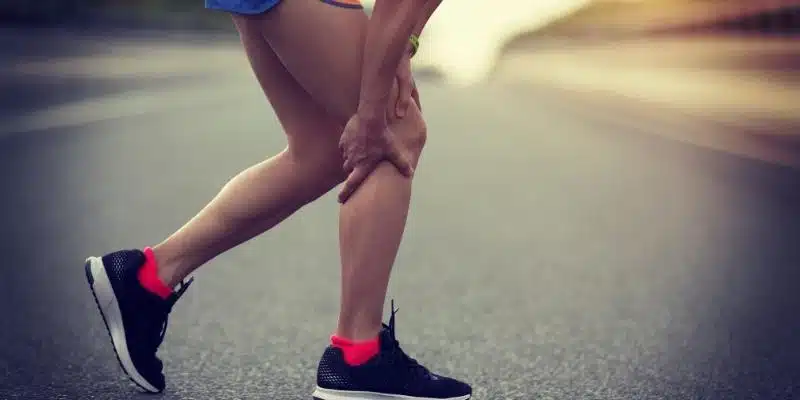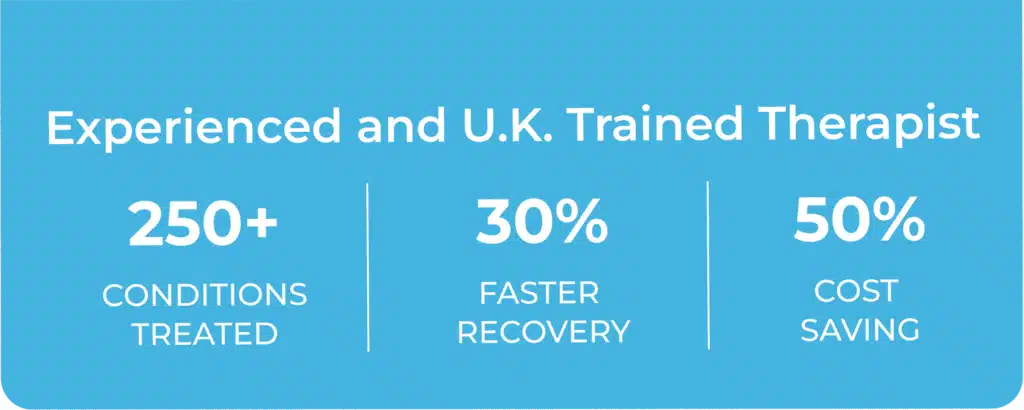
A meniscus tear is not the end of an active life — it’s the beginning of recovery done right. With today’s advanced physiotherapy for meniscus tear, most patients can heal naturally without surgery. The goal is to help your knee move better, get stronger, and stay stable for life. We don’t just focus on the pain; we retrain your muscles, balance, and confidence so every step feels normal again.
Modern meniscus tear physiotherapy uses a science-based approach — combining strength training, flexibility work, and balance retraining. These techniques restore knee motion, reduce swelling, and protect against future tears.
A meniscus tear is one of the most common knee injuries seen in both active adults and older adults. Whether it happens during sports, a sudden twist, or simply standing up awkwardly, a torn meniscus can cause pain, swelling, and difficulty in movement.
But here’s the good news — most meniscus tears can heal effectively with physiotherapy for meniscus tear. With proper exercises, guidance, and consistency, you can restore knee strength, stability, and confidence without surgery.
This guide explains everything about meniscus tear physical therapy, from understanding the injury to detailed rehab exercises, recovery timelines, and expert-backed physiotherapy protocols.
The meniscus is a C-shaped piece of cartilage inside your knee that works as a cushion between the thigh bone (femur) and shin bone (tibia). Each knee has two menisci — one on the inner side (medial) and one on the outer side (lateral).
When this cartilage gets torn because of a sudden twist, squat, or heavy load, it is called a meniscus tear. The tear can be small or large, partial or complete.
A meniscus tear can happen suddenly — often during a twist, squat, or quick change in direction. Recognizing the symptoms early helps prevent long-term knee problems.
You may have a meniscus tear if you notice any of these warning signs:
If these symptoms sound familiar, it’s important to start meniscus tear physiotherapy as soon as possible. Early physiotherapy helps control swelling, protect the joint, and restore stability safely — preventing long-term cartilage damage or chronic pain.
Accurate diagnosis is the first step toward effective treatment. A physiotherapist or orthopedic specialist will carefully evaluate your knee to identify the type and extent of the meniscus tear.
Here’s how the diagnosis is usually made:
After reviewing these findings, your specialist will decide the best approach — whether you need surgical intervention or can recover effectively through meniscus tear physical therapy. In many cases, early physiotherapy and guided exercises can help avoid surgery altogether and restore full knee function naturally.
Also Read: Physiotherapy For Joint Pain ; Physiotherapy For Disc Burge
Physiotherapy is one of the most important parts of healing after a meniscus tear — whether you’ve had surgery or not. It helps your knee recover strength, movement, and stability in a safe and natural way.
The main goals of physiotherapy for meniscus tear are:
A structured meniscus tear physical therapy plan rebuilds your knee step by step. As your pain reduces and strength returns, your physiotherapist will progress your meniscus rehab exercises — from basic stretches to functional movements like squats or balance drills.
With time and consistency, physiotherapy helps your knee move freely again, letting you walk, climb, and play without discomfort.
Every recovery journey after a meniscus tear follows three key stages.
The length of each stage depends on your age, fitness, and how severe your tear is.
A skilled physiotherapist designs a personalized meniscus tear rehabilitation plan to help your knee heal safely and fully.
Goal: Control pain and swelling, and restore gentle knee motion.
In the early stage, your physiotherapist focuses on reducing inflammation and helping you move your knee safely.
You’ll start with light meniscus tear physio exercises such as:
During this phase, avoid deep squats, twisting, or heavy movements.
Gentle, regular movement is encouraged, but rest is equally important to allow the cartilage to begin healing.
Goal: Build strength, improve flexibility, and restore joint stability.
Once pain and swelling are under control, your physiotherapist introduces meniscus tear physical therapy exercises that target muscle recovery.
Common treatments include:
The focus here is to improve motion and strength without causing pain.
Over-stretching or pushing too hard may slow recovery, so your physiotherapist adjusts the intensity each week based on your comfort.
Goal: Restore full strength, balance, and return to daily or sports activities.
In this final stage, your physiotherapy for meniscus tear shifts toward regaining full control and confidence in your knee.
Exercises in this phase may include:
By the end of this phase, you should be able to walk, climb stairs, and move comfortably without pain.
Your physiotherapist may also add meniscus rehab exercises for agility and sport-specific drills if you plan to return to running or sports.
However, it’s important to return to full activity only after complete recovery and when your physiotherapist confirms that your knee is strong and stable enough.
| Stage | Phase | Goal | Key Physiotherapy Treatments | Precautions |
|---|---|---|---|---|
| Stage 1 | Early Phase (0–3 Weeks) | Control pain and swelling, restore gentle motion | Ice therapy, compression, ankle pumps, heel slides, quadriceps setting | Avoid deep squats or twisting |
| Stage 2 | Strength & Mobility (3–8 Weeks) | Build strength and flexibility | Straight leg raises, bridging, mini squats, heel props, hamstring curls | Don’t over-stretch or push into pain |
| Stage 3 | Advanced Rehab (8–16 Weeks) | Restore full strength and return to activity | Step-ups, cycling, proprioception training, balance drills, side leg raises | Return to sports only after full control |
Each meniscus tear physiotherapy treatment plan is tailored to your specific condition. A physiotherapist tracks progress weekly and adjusts exercises based on pain, swelling, and movement.
Also Read: Physiotherapy For Back Pain ; Physiotherapy For Knee Pain
When Rohan, a 38-year-old software engineer, twisted his knee while playing badminton, he felt a sharp pain and swelling within hours. An MRI confirmed a medial meniscus tear. Instead of opting for surgery, he began meniscus tear physiotherapy through Resolve360’s online sessions.
Treatment Plan:
Outcome:
Within 12 weeks, Rohan regained full knee movement, could walk without pain, and even returned to light sports.
He avoided surgery — all thanks to consistent meniscus tear rehab exercises and guided physiotherapy support from Resolve360.
Key Takeaway:
Most small to moderate meniscus tears can heal naturally with structured physiotherapy and commitment. Surgery is not always the first answer — proper exercise and expert guidance often deliver lasting recovery.
These exercises are part of most meniscus tear physiotherapy treatment programs.
They help you regain strength, stability, and movement after injury or surgery.
Always do them under the guidance of a physiotherapist, especially in the early recovery phase.
After a meniscus tear, the thigh muscles (quadriceps) often become weak. This simple exercise activates them without bending the knee — ideal for early rehab.
How to do it:
How it works : It strengthens the quadriceps without putting stress on the meniscus or knee joint, helping prevent muscle loss during rest.
Benefits:
Pro Tip: Place a small rolled towel under your knee for added comfort and control.
This exercise helps rebuild the main front-thigh muscle, crucial for walking, standing, and climbing stairs after a meniscus tear physio plan begins.
How to do it:
How it works: It strengthens the quadriceps while keeping the knee stable, promoting proper alignment.
Benefits:
Pro Tip: Move slowly — lifting too fast reduces muscle engagement.
The hamstrings (back thigh muscles) support knee bending and stability. Strengthening them helps balance the forces around your joint.
How to do it:
How it works: This exercise strengthens the posterior muscles that protect the meniscus from overloading.
Benefits:
Pro Tip: Avoid swinging your leg; perform controlled movements only.
After an injury or surgery, stiffness is common. Heel slides gently restore bending (flexion) without overstressing the joint.
How to do it:
How it works: It maintains mobility and prevents scar tissue from limiting your motion.
Benefits:
Pro Tip: If you feel pain or tightness, reduce the range and increase gradually over time.
Mini squats are a safe, functional exercise that builds strength in the thighs and hips without putting too much pressure on the meniscus.
How to do it:
How it works: It strengthens the quadriceps, hamstrings, and glutes together — crucial for balance and controlled movement.
Benefits:
Pro Tip: Avoid deep bending or jerky motion — small angles are safer and equally effective early on.
This simple move strengthens your calves and improves balance — both essential for walking and joint control during meniscus tear rehabilitation.
How to do it:
How it works: It activates calf muscles, which support knee alignment and stability when walking or climbing stairs.
Benefits:
Pro Tip: Add this exercise later in your rehab when pain-free standing is comfortable.
This is one of the best meniscus tear exercises for hip strength. Strong hips help control knee position and reduce inward collapse during movement.
How to do it:
How it works: It activates the gluteus medius, which stabilizes the pelvis and improves knee alignment.
Benefits:
Pro Tip: Don’t roll your hips backward — keep them stacked to engage the right muscles.
This move rebuilds quadriceps strength in a controlled way and prepares your leg for daily activities like walking and climbing stairs.
How to do it:
How it works: It isolates the quadriceps while maintaining joint control and muscle tone.
Benefits:
Pro Tip: Avoid locking the knee at the top; maintain slight softness to protect the joint.
Glutes and hamstrings work together to stabilize your knee. This exercise builds that foundation during meniscus tear physical therapy.
How to do it:
How it works: It strengthens posterior chain muscles and promotes coordination between hips and knees.
Benefits:
Pro Tip: Engage your core and avoid arching your back — focus on squeezing the glutes.
This exercise targets the outer thigh and hip muscles that help your knee stay aligned during movement.
How to do it:
How it works: It strengthens the lateral stabilizers of the hip, which prevents knee collapsing inward during activity.
Benefits:
Pro Tip: Keep your toes facing forward, not upward, for proper muscle engagement.
Even a short, consistent routine can make a big difference in your recovery.
You don’t need fancy equipment — just focus, control, and daily effort.
Here’s a simple, time-based plan physiotherapists often recommend for meniscus tear rehabilitation.
Goal: Warm up the muscles, improve blood circulation, and maintain joint motion.
Goal: Restore strength, reduce stiffness, and train muscle coordination.
Goal: Improve end-of-day flexibility and boost circulation before rest.
It’s not about how long you exercise — it’s about how regularly you move.
Doing these meniscus tear physio exercises daily improves pain, flexibility, and knee strength.
Over time, this short 10-minute plan supports full recovery and prevents future knee injuries.
Recovering from a meniscus tear takes time, and each stage has a specific goal. The duration may vary based on your age, activity level, and whether the injury was treated with or without surgery. Below is a general recovery timeline to guide expectations:
| Week | Focus Area | Expected Progress |
|---|---|---|
| 0–3 Weeks | Pain and swelling control | Gentle knee movement, less inflammation |
| 3–6 Weeks | Early strengthening | Better mobility, improved muscle control |
| 6–10 Weeks | Advanced exercises | Stronger thigh and hip muscles |
| 10–16 Weeks | Balance and function | Walking, cycling, or light sports possible |
The first phase focuses on rest, ice, compression, and elevation (RICE). Gentle knee movements and light exercises like ankle pumps and quad sets are introduced to maintain circulation and prevent stiffness. The goal is to reduce inflammation and restore slight mobility without strain.
As pain and swelling decrease, light strengthening begins. Exercises such as straight leg raises, heel slides, and mini squats help rebuild quadriceps and hamstring strength. Controlled motion is important — no deep bending or twisting during this stage.
The focus shifts to rebuilding full strength and coordination. Resistance bands, stationary cycling, and step-up exercises are added to challenge muscles while protecting the knee joint. Balance training starts to prepare the knee for real-life movement.
This phase restores normal knee function. Patients can usually resume low-impact sports, brisk walking, or light jogging under guidance. Proprioception and agility drills are key to regaining full control and preventing future injuries.
Not every meniscus tear requires surgery. In many cases, meniscus tear physiotherapy and rest are enough for full recovery. Your physiotherapist will first focus on reducing pain, improving motion, and strengthening the knee through a structured program.
However, surgery may be considered if:
Even after surgical repair, meniscus tear physical therapy is essential for regaining motion, rebuilding strength, and returning to daily activities safely. A guided rehab plan helps protect the repaired tissue and prevents future knee problems.
With today’s busy lifestyle, many people prefer online physiotherapy for meniscus tear recovery. It offers comfort, flexibility, and expert care without the need to travel.
Through platforms like Resolve360, you can connect directly with certified physiotherapists who guide you through every stage of healing — from pain relief to full knee strength. Each online session includes:
You can join from anywhere in India, the USA, the UK, or globally through the Resolve360 app, available on both the Play Store and App Store.
Their team ensures your meniscus tear physiotherapy program is safe, effective, and tailored to your condition — so you recover fully, right from home.
Also Read: Physiotherapy For Meniscus Tear ; Physiotherapy for acl tear
Recent evidence has strengthened the role of physiotherapy in meniscus-tear care. Key findings include:
What this means: Guided, structured physiotherapy for meniscus tears is not just effective—it is increasingly supported by high-quality clinical research. Whether you’re recovering non-surgically or post-surgery, a well-planned meniscus tear physical therapy program improves outcomes, reduces dependency on surgery, and enhances long-term knee health.
Keeping your knees healthy and strong is the best way to prevent a meniscus tear. Follow these simple tips to protect your knee joints in the long run:
These steps not only protect your knees but also improve your overall joint health, keeping you active, mobile, and pain-free.
At Resolve360, physiotherapy is designed to fit your life — no matter where you are. Our expert physiotherapists create customized meniscus tear physiotherapy treatment plans that focus on pain relief, strength rebuilding, and full recovery.
Through live online sessions, you get one-on-one guidance, exercise correction, and weekly progress tracking — all from home. Whether you’re in India, the UK, the USA, or anywhere across the world, you can connect easily through the Resolve360 app, available on both Play Store and App Store.
Every recovery plan follows the latest meniscus rehab protocol and includes gentle, safe exercises for faster healing. With expert care, global access, and a personalized approach, Resolve360 helps you move confidently again — without unnecessary travel or stress.
Move stronger. Heal smarter. Recover with Resolve360.
Yes. Physiotherapy for a meniscus tear helps reduce pain, restore movement, and strengthen the knee joint. Most small or stable tears heal naturally with guided physiotherapy, helping patients avoid surgery and regain normal joint function safely.
The best exercises include heel slides, quad sets, hamstring curls, straight leg raises, and mini squats. These movements improve strength, stability, and flexibility without putting excess strain on the knee cartilage.
A complete rehabilitation program usually lasts 8–16 weeks. Early stages focus on pain relief and gentle motion, followed by strengthening and balance training to restore full knee function and prevent re-injury.
Yes, many partial or minor meniscus tears heal completely with regular physiotherapy. Guided exercises and proper rest help reduce inflammation, rebuild cartilage support, and improve joint mechanics — often avoiding the need for surgery.
The quadriceps setting exercise is one of the best for a meniscus tear. It strengthens thigh muscles without stressing the knee, supports the joint, and reduces pain. It can be combined with leg raises and bridges for better recovery.
Physiotherapy can usually begin within a few days of the injury, once swelling decreases. Early sessions focus on gentle range-of-motion and activation exercises under professional supervision to prevent stiffness and promote faster healing.
Rehabilitation progresses through phases — pain control, mobility restoration, and muscle strengthening. Common exercises include bridging, mini squats, and hamstring curls, all aimed at rebuilding stability and function after injury or surgery.
The fastest recovery comes from early physiotherapy, consistent exercise, and avoiding overloading the joint. Ice, compression, and guided rehab sessions help control swelling and safely rebuild knee strength.
Yes. Physiotherapy often prevents surgery by improving joint stability, muscle strength, and movement control. Targeted rehabilitation programs allow the knee to heal naturally in many mild to moderate cases.
Yes. Online physiotherapy provides real-time guidance, personalized exercise plans, and progress tracking. With professional supervision, patients can recover effectively and safely from home.

Dr. Nidhi Kumari
She has persuaded her bachelor’s from SGT University, Gurugram, she has done her internship at Dr. Ram Manohar Lohia Hospital, and persuade her Master in Physiotherapy from Chaudhary Charan Singh University, Meerut. She has previously worked with Orthocure clinic, Dr.Nasir physiotherapy rehabilitation, Quantum physiotherapy, and wellness center.
If you have more questions.

Dr. Nidhi
She has persuaded her bachelor’s from SGT University, Gurugram, she has done her internship at Dr. Ram Manohar Lohia Hospital, and persuade her Master in Physiotherapy from Chaudhary Charan Singh University, Meerut. She has previously worked with Orthocure clinic, Dr.Nasir physiotherapy rehabilitation, Quantum physiotherapy, and wellness center.
If you have more questions.




























Also Read: Back Pain: Causes and Treatment
If you would like to know more about any of the health conditions, please fill up the form below and talk to Doctors on Resolve360 directly by asking a question.
We are your doctor’s first choice and trusted by 50,000+ patients.



We are your doctor’s first choice and trusted by 50,000+ patients.

We are your doctor’s first choice and trusted by 50,000+ patients.

Resolve360 is great platform for online physiotherapy.
I was suffering from scapula dyskinesia and had lot of pain in right shoulder movement. I was introduced to Resolve 360 by my oncologist.
Within a month (26 sessions) there was a considerable improvement. Sessions are very cost-effective and doctors are very kind and efficient.
Doctor David has been really great and helpful. I would highly recommend Resolve 360.


I took prenatal care program from Resolve 360. Dr. Preyrna was assigned to me and she has done commendable job. I did prenatal exercises under her supervision, she designed program according to my body need. With her help my pregnancy was healthy and I got good dilations at the time of delivery. I am blessed with a healthy baby girl and very happy with Resolve 360.


Best therapy sessions that too at home and timings are very flexible. I had a issue in my neck and lower back since almost 4 to 5 years, taken so many treatments and physio sessions. But all gave a temporary relief. Then my friend referred me this Resolve 360 in 2020, in starting i was hesitant as everything was online, but after taking almost 10 sessions i got much relief, and now i am almost free of pain. Thanks to the team of Resolve 360.












I had online Physiotherpy sessions by Prerana for my heel pain. ( Tendo Achilis Sprain).
Though virtual, it was more interactive.
She was very observant throughout the sessions, correcting me while doing the exercises and was assertive in her outlook.
I found her instructions and methodology very helpful. She is updated in her academic knowledge in the field of Physiotherpy. She clarified my doubts about the role of Laser and Ultrasound treatment quoting evidence based data. With my personal experience I agree with her opinion that these are more of placebo effect.
Physiotherpy though not a miracle treatment, is a compelling necessity to most of the musculoskeletal and neurological illnesses. It needs to be accepted as healthy way to live.


From being a couch potato with poor cardio respiratory system to reaching pre-athlete levels of fitness in a span of 3 months, my journey with Resolve360 and Dr.David (Physiotherapist) has been anything but magical!
About 3 to 4 months ago, my blood report showed very high bad cholesterol levels, I was low on stamina and had frequent breathing issues. My GP prescribed me cholesterol meds for a month but I felt that alone wouldn’t get me back in shape because I needed a major lifestyle overhaul.
Dr.David educated me about my condition in detail and where it could lead me to if I don’t take action in the long run. He put me on a balanced workout regime being easy with cardio workouts in the initial days and gradually upgraded it observing me closely. He also advises me on dietary choices and follows up frequently. During the initial days, my ears used to get blocked within 5 wall squats and I stop right away but now I do over 20 in one shot and hardly feel a thing. I used to lose balance and fall off over my face within 6 push-ups or 20 seconds of plank and now I do about 24 push-ups in one shot. My heart rate used to raise above 150 bpm doing jumping jacks or other cardio workout within 20-30 seconds. You won’t believe I don’t do any of these cardio workouts without additional weights on my feet these days and my heart rate and recovery are as steady as they could get. I couldn’t run for over 2 min without stopping and gasping and now I cover about 4.6 km in 30 min and follow-up with a 20 min walk. Not convinced yet? My VO2 Max (I use an Apple Watch to measure this stat) was just about 33 while I started with Resolve360 and David. That reflects a very poor cardio respiratory fitness for a 34 year old. It’s 43.5 today ! Easily above average. Please read upon about VO2 Max and how it directly relates to cardio respiratory fitness so you get an accurate picture about my monumental progress in the last 3 months. I’ve been trying to get into a regular physical workout and balanced diet discipline since my 20s but I’d never been so motivated as I’m now. Give these guys a try. After all, the best investment you could ever make is on your health !


We contacted resolve360 for our child speech issue and I must say Resolve 360 team and Apoorva doing a wonderful job.
Our speech therapist Jaslia from Resolve360 is having a excellent knowledge and it helps our child a lot. Jaslia understand child psychology very well. Due to her efforts, we are seeing tremendous improvements in our child. She has a strong dedication towards her work and her nature towards kids makes her a very special one. She has given us enough confidence, due to her efforts and excellent service, we are seeing good improvements for my child speech & communication skills.
I would highly recommend Jaslia & Resolve360 team for their excellent work. God bless you!!

